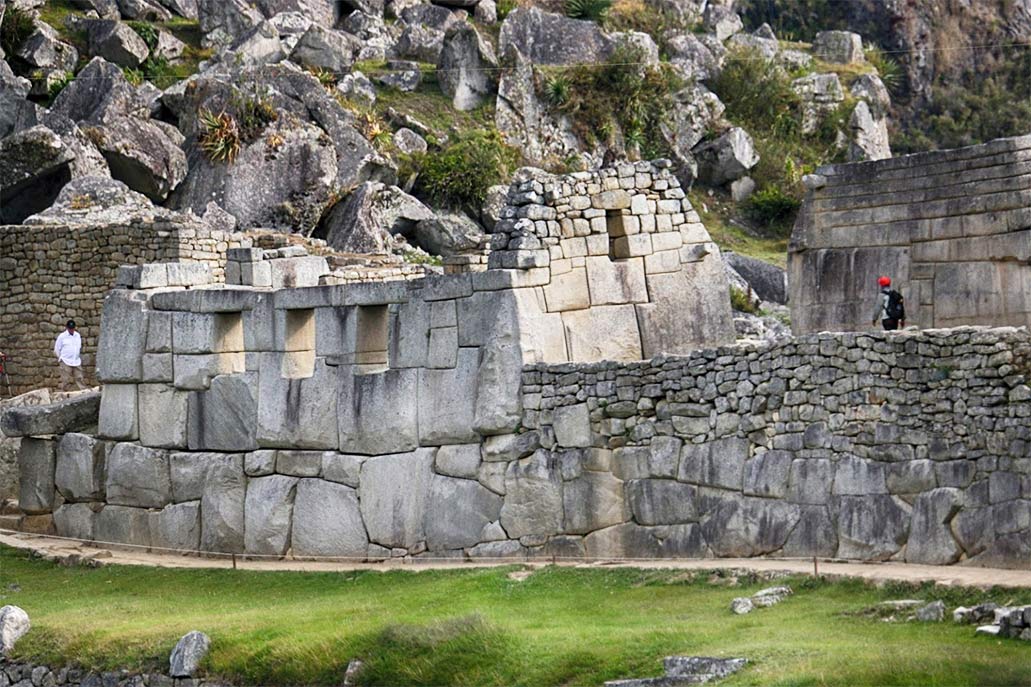The Temple of the 3 Windows
The Temple of the 3 Windows is one of the most surprising constructions in Machu Picchu. The carving of its walls is perfect. There are several hypotheses as to why they built three huge windows there with incredible views of the mountain range. It is presumed that the purpose was to worship the Inca gods, especially those who guard the tripartite world of the Incas: the heavenly world (Hanan pacha), the earthly world (Kay pacha) and the underworld (Uku pacha).

Content
The temple of the Three Windows of Machu Picchu
Just a few steps from the Main Square, in the heart of the religious sector, is this temple, one of the most amazing in Machu Picchu. It is an immense trapezoidal wall, 10 meters long and 4 meters wide, built with huge stones carved and assembled to perfection.
All three windows are also trapezoidal. On both sides there are two additional closed windows (like niches) where the Incas left ceremonial objects of gold and silver. These constructions are currently closed to visitors.
The temple served a religious function. The white granite stone with which it was built has a different carving from the rest of the constructions at Machu Picchu. The fineness of its walls indicates that it was one of the most important buildings in the citadel.
A few steps from this temple there are other buildings with religious purposes of great importance: the Main Temple, the Temple of the Sun and the Intihuatana.
The Inca trilogy
There are many hypotheses about the religious rituals that were performed in the Temple of the 3 Windows. It is believed that the Inca worldview of the world divided into three worlds was worshiped: the heavenly world (Hanan pacha), the earthly world (Kay pacha) and the underworld (Uku pacha).
For the Incas, the Hanan pacha was the world of the gods, of the celestial beings (the sun, the moon, the stars). The Kay pacha was the earthly world, of men and animals. Finally, the Uku pacha was the world of the dead, of beings that wait to reincarnate to return to the earthly world.
The tripartite world of the Incas was represented by three animals: the condor (kuntur), the puma (puma) and the snake (amaru). The ‘three’ is present in many of the Inca constructions such as the ‘chakana’ (also called the Andean cross) present in the Temple of the Sun in Ollantaytambo.

The inscription on the stone
On the wall of the Temple of the Three Windows there was an inscription dated July 14, 1902 where it was displayed “Agustín Lizárraga, Enrique Palma, Justo Ochoa and Gabino Sánchez. All of them were Cuzco who lived around the place. Agustín Lizárraga was the tenant of the lands. The others were his workers.
Nine years after that visit to Machu Picchu, in 911, the American explorer Hiram Bingham arrived in the Inca city. In one of the photos in his book ‘The Lost City of the Incas’, the photo with the aforementioned inscription was disseminated.
After his visit to Machu Picchu in 1911, Hiram Bingham and his exploratory team erased the inscription on the Temple of the 3 Windows.
How to get there?
Any entrance to Machu Picchu allows you to visit the Temple of the 3 Windows. This venue is open every day of the year at the established hours: from 6 in the morning to 5 in the afternoon.
To get there you have to walk about 30 minutes from the entrance to Machu Picchu. The temple is in the religious sector, next to the famous Main Temple.
More information
The Temple of the 3 Windows was built with the stone bench located in Machu Picchu (a few meters from the place). The construction of the Inca citadel is closely related to the existence of the immense bank of stones.
Through the windows of the temple it is possible to appreciate the Huayna Picchu mountain as well as the sunrise and its position in the sky. Currently it is not allowed to touch the structure or lean out of the windows. It is only allowed to observe this construction from a safe distance.